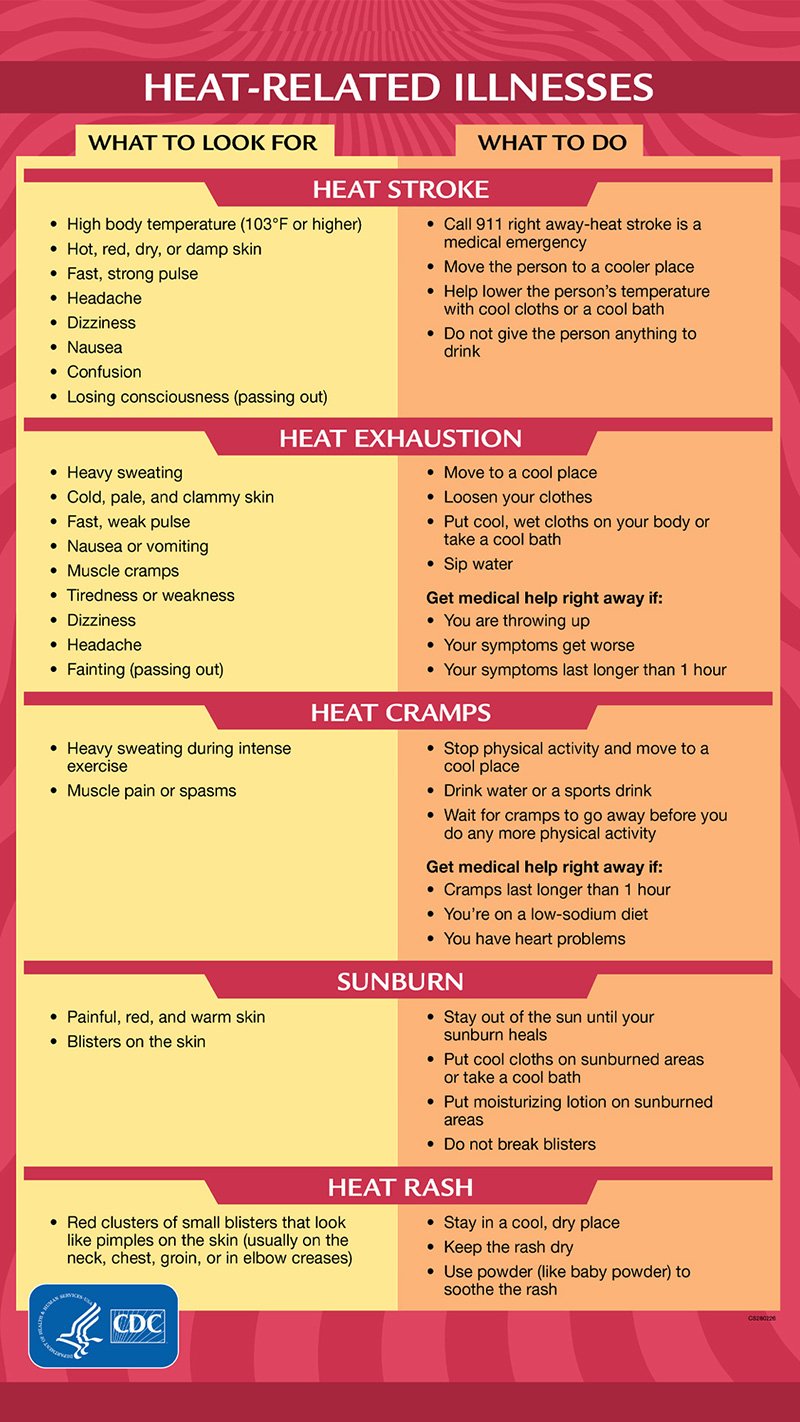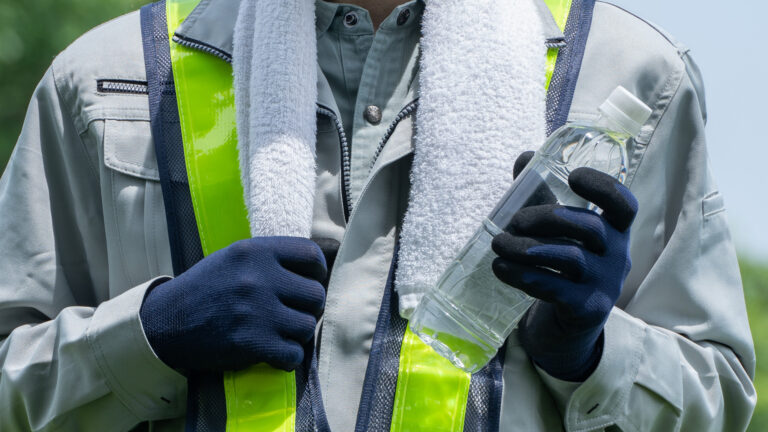Workers who are exposed to excessive heat or work in hot surroundings may develop heat stress. Excessive heat can cause workplace illnesses and injuries. Heat stress can cause heat stroke, tiredness, cramps, and rashes. Heat can significantly raise the risk of other injuries by causing sweaty hands, foggy safety glasses, and dizziness.

TYPES OF HEAT RELATED ILLNESSES
Heat Stroke
Heatstroke is the most severe heat-related illness. It occurs when the body loses control of its temperature: the body’s temperature increases rapidly, the sweating process fails, and the body is unable to cool itself. When heat stroke occurs, the body temperature can reach 106°F or greater in 10 to 15 minutes. If heat stroke is not treated immediately, the person may suffer lasting disability or even death.
Symptoms include:
• Confusion, altered mental status, slurred speech
• Loss of consciousness (coma)
• Hot, dry skin or profuse sweating
• Seizures
• Very high body temperature
• Fatal if treatment delayed
First Aid:
• Call 911 for emergency medical care.
• Stay with the worker until emergency medical services arrive.
• Move the worker to a shaded, cool area and remove outer clothing.
• Cool the worker quickly, using the following methods:
– With a cold water or ice bath, if possible
– Wet the skin
– Place cold wet cloths on the skin
– Soak clothing with cool water
• Circulate the air around the worker to speed cooling.
• Place cold wet cloths or ice on the head, neck, armpits, and groin; or soak the clothing with cool water.
Heat Exhaustion
Heat exhaustion is the body’s response to an excessive loss of water and salt, usually through excessive sweating.
Heat exhaustion is most likely to affect:
• The elderly
• People with high blood pressure
• Those working in a hot environment
Symptoms include:
• Headache
• Nausea
• Dizziness
• Weakness
• Irritability
• Thirst
• Heavy sweating
• Elevated body temperature
• Decreased urine output
First Aid
• Take worker to a clinic or emergency room for medical evaluation and treatment.
• Call 911 if medical care is unavailable.
• Have someone stay with the worker until help arrives.
• Remove the worker from the hot area and give liquids to drink.
• Remove unnecessary clothing, including shoes and socks.
• Cool the worker with cold compresses or have the worker wash their head, face, and neck with cold water.
• Encourage frequent sips of cool water.
Rhabdomyolysis
Rhabdomyolysis (rhabdo) is a medical condition associated with heat stress and prolonged physical exertion. Rhabdo causes the rapid breakdown, rupture, and death of muscle. When muscle tissue dies, electrolytes and large proteins are released into the bloodstream. This can cause irregular heart rhythms, seizures, and damage to the kidneys.
Symptoms include:
• Muscle cramps/pain
• Abnormally dark (tea or cola-colored) urine
• Weakness
• Exercise intolerance
• Asymptomatic
First Aid
• Stop activity
• Drink more liquids (water preferred)
• Seek immediate care at the nearest medical facility.
• Ask to be checked for rhabdomyolysis (i.e., blood sample analyzed for creatine kinase).
Heat Syncope
Heat syncope is a fainting (syncope) episode or dizziness that usually occurs when standing for too long or suddenly standing up after sitting or lying. Factors that may contribute to heat syncope include dehydration and lack of acclimatization.
Symptoms include:
• Fainting (short duration)
• Dizziness
• Light-headedness from standing too long or suddenly rising from a sitting or lying position
First Aid
• Sit or lie down in a cool place.
• Slowly drink water, clear juice, or a sports drink.
Heat Cramps
Heat cramps usually affect workers who sweat a lot during strenuous activity. This sweating depletes the body’s salt and moisture levels. Low salt levels in muscles cause painful cramps. Heat cramps may also be a symptom of heat exhaustion.
Symptoms:
• Muscle cramps
• Pain, or spasms in the abdomen, arms, or legs
First Aid
• Drink water and have a snack or a drink that replaces carbohydrates and electrolytes (such as sports drinks) every 15 to 20 minutes.
• Avoid salt tablets.
• Get medical help if the worker:
o Has heart problems.
o Is on a low sodium diet.
o Has cramps that do not subside within 1 hour.
Heat Rash
Heat rash is a skin irritation caused by excessive sweating during hot, humid weather.
Symptoms include:
• Red clusters of pimples or small blisters
• Usually appears on the neck, upper chest, groin, under the breasts, and in elbow creases
First Aid
• Work in a cooler, less humid environment, if possible.
• Keep the rash area dry.
• Apply powder to increase comfort.
• Don’t use ointments and creams.






